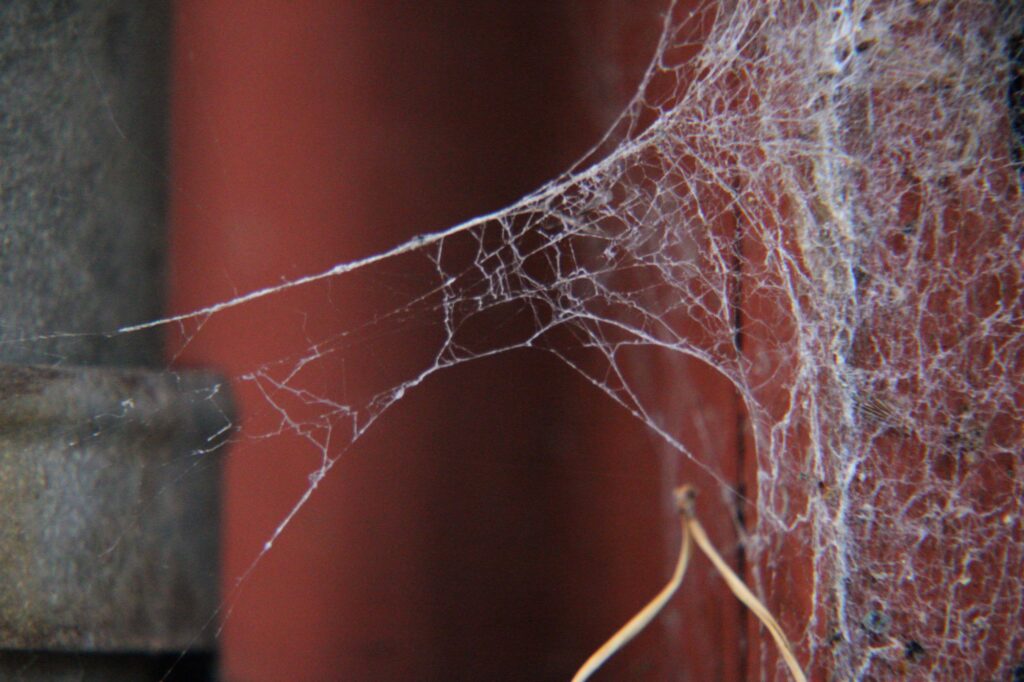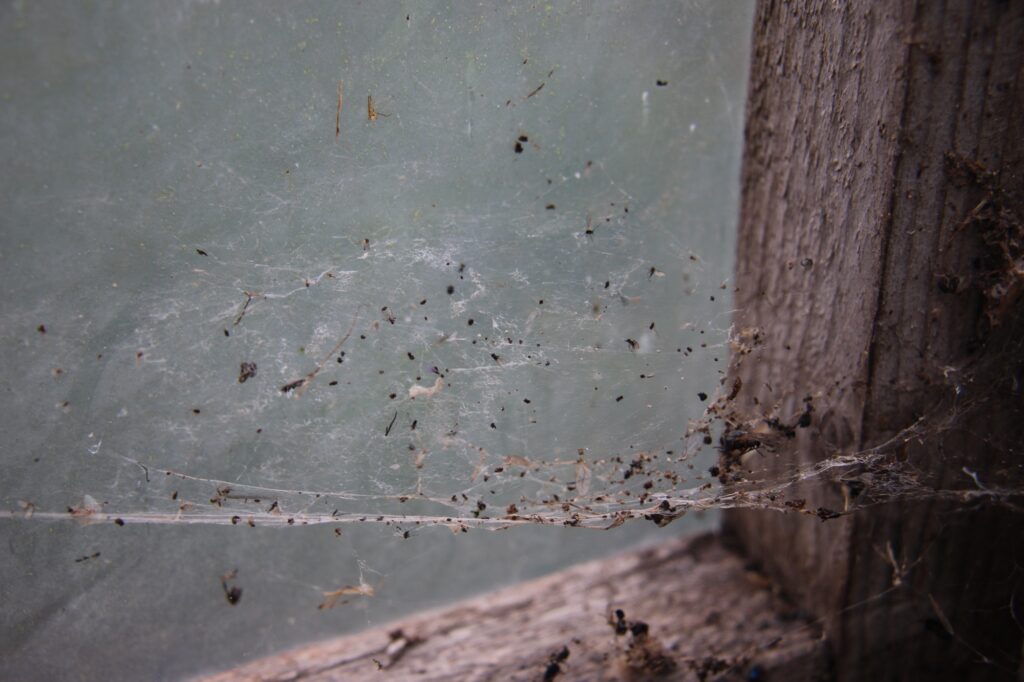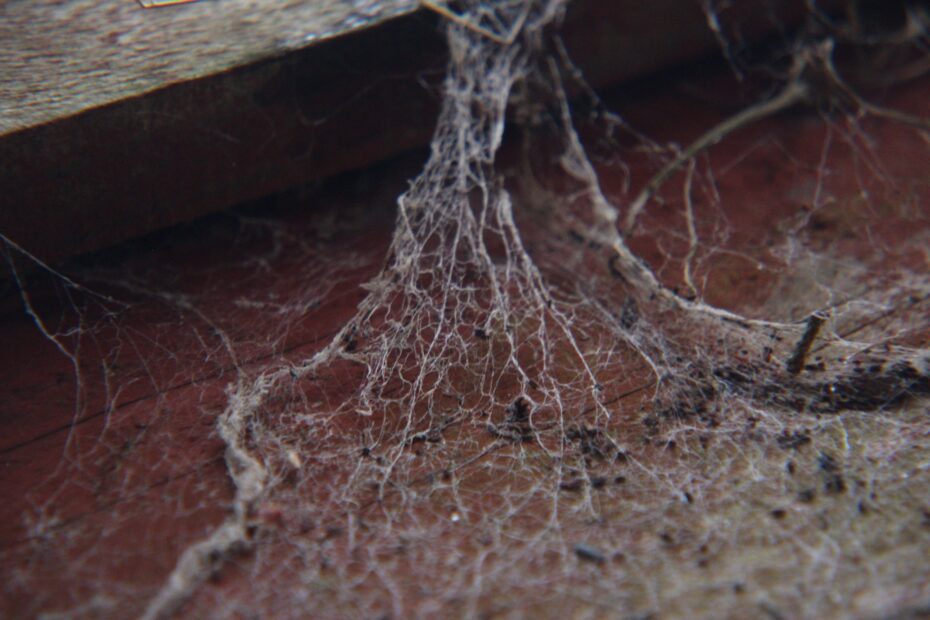
Research documentation – November 2025
This morning started with a simple plan: collect moth wings and butterfly wings from the spider webs in our polytunnel to use for cyanotypes. I wanted to capture these delicate fragments – the remains caught in old webs, archives of what had been trapped there.
But as I started looking at the webs themselves, something shifted. I became more interested in the actual webs than what they contained. In my recent tutorial with Jonathan, we’d talked about capture and he I was staring at things captured by spiders. I felt an affinity with them. I started to see these old webs being like archives of insects with only their wings left behind. My mind moved to: how could I capture the spider webs themselves?
I didn’t have my camera with me, so I thought maybe I could lift them onto glass or plastic. I went to the shed and got a big roll of cling film – clear plastic wrap – thinking I could use it to capture the webs, roll them up, and embed them directly in cyanotypes or maybe in encaustic wax.
The Walk: Finding What’s Already There
I set out walking around outside the polytunnel with my plastic film, looking for spider webs. But I couldn’t find any. They eluded me.
I wandered past our big water tank, clutching my plastic wrap. The tank collects rainwater, from an old caravan roof. It’s where we get water for the chickens and sheep. The water inside caught my eye: the surface there were flies floating, leaves scattered across it. I stopped. What a lovely surface, I thought. I’d love to photograph that.
I moved on to the shabby old caravan. I peered into the windows, but was actually more interested in the surface of the glass. I noticed these incredible silvery trails. Memory trails. Slug or snail trails left on the glass. Secret paths catching the light. And I thought: this is exactly what I’m trying to do. The window is already doing it. Already capturing, already documenting and in the most natural way.
I walked past the poly tunnel again, and I noticed the walls – covered in slug trails. Silvery paths on plastic. Marks of movement, of searching and seeking.
The Moment of Feeling Redundant
I stopped and sat down on the bare earth inside the tunnel. I couldn’t find the spider webs I was looking for.
And I thought: I’m now redundant. Insects are doing the work I’d so busily set out to do.
Here I was, walking around with my piece of plastic film, thinking I was going to capture things. But instead I’d noticed that nature was already busy capturing. Without an audience, without a plan or agenda. The water tank was already capturing flies and leaves. The caravan windows were already capturing snail trails. The polytunnel walls were already capturing trails.
Everything I was trying to do was already being done.
The water tank surface – that’s already a composition. The snail trails on glass – that’s already drawing, already mark-making, already an archive of movement. The slug trails on plastic – already beautiful, already significant. I smiled at my misjudged human way of barging in on things..trying to impose my way of doing things.
The Shift: From Capturer to Witness
It hit me: I’m not the capturer. I’m the witness.
I’m not here to recreate a natural phenomenon. I’m here to recognize what’s already happening. To see it. To photograph it. To say: this matters. This is significant. This is what insects have created- not artificially or for anyone to see. But it deserves to be seen. This unseen labour around us.
Maybe I’m not redundant after all. Maybe my role just isn’t what I thought it was.
Coming Back: Knowledge of Place
With eyes wide open after being firmly put in my place- I searched again. This time I found the spider webs – ancient ones. I’ve been monitoring these webs for years. I know which ones are active and fresh – the delicate ones spun overnight to catch morning flies. And I know which ones are abandoned, years old, dust-laden and ragged.
I only use the really old webs. The ones that have been there for years and years. That’s the beauty of living on a farm that’s been here for a long time. I have knowledge of this place.
I know what lives here. I know where to find mushrooms. I know about the different soils on the croft – where the clay is, where the sand is. If I want to harvest oak galls, I know where to look.
This knowledge – this attention over time – that’s part of the work too. I think I would find it incredibly difficult to go to a new place and see things immediately. It needs to be studied. You need to know the rhythm, the light, what lives there, but most importantly you need to approach observing it in the right way.

What This Means
This is about documenting usually unseen processes. Things that are already happening.
I’m not making them happen. I’m recognizing them. Looking at them. Preserving them through different means – cyanotypes, photography, perhaps video.
The slug has already done the work. The snail has already drawn on glass. The spider has already woven these cobwebs. The raindrop is already being a lens without me noticing it.
My work is to see it. To photograph it. To work with it in processes where I’m not entirely sure of the outcome. To say: these small things matter. Look. See what’s already here because maybe we can learn something from it.
It’s collaboration, but silent collaboration. No word between species. I’m capturing, but not to trap. I’m documenting freedom, creativity, the work that nature does without human intervention.
I’m not redundant. I’m just not what I thought I was.
I’m the witness. And maybe that’s enough for today.
This post documents a shift in my thinking about capture, collaboration, and the role of the artist as witness rather than maker. It connects to my ongoing research into photographic documentation, and non-human agency in image-making.

